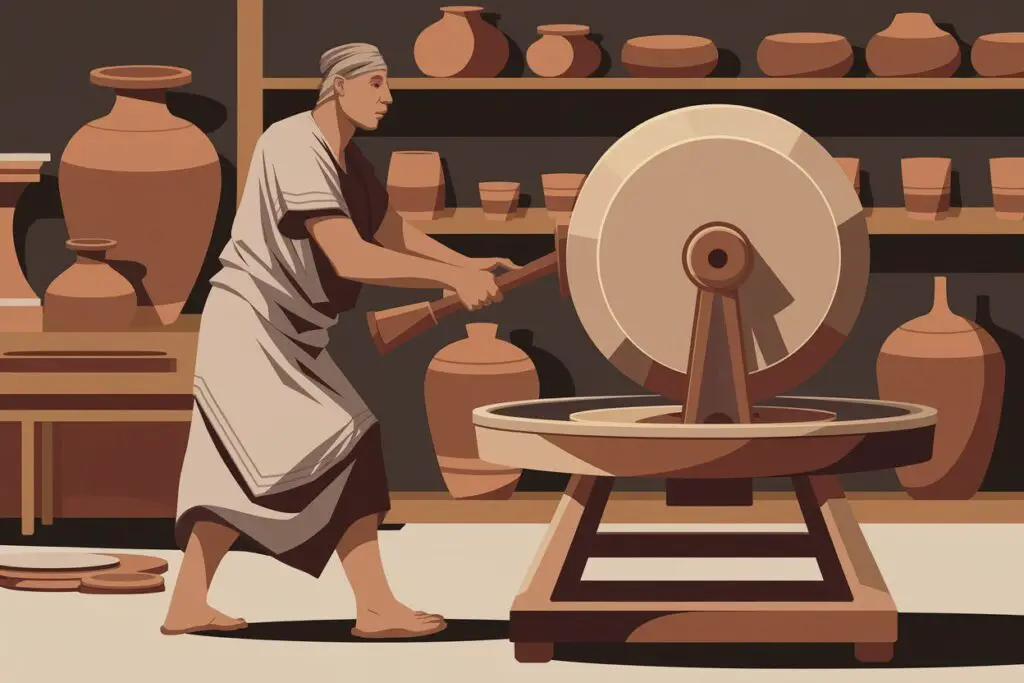When you think of the wheel, it’s easy to imagine chariots racing across ancient battlefields or carts trundling down dusty roads. But here’s the twist: the wheel’s story begins not on the road, but in the workshop of a potter. Around 3500 BCE, in the cradle of civilization—Mesopotamia—this groundbreaking invention emerged, not as a transportation tool, but as a game-changing device for pottery-making. The Sumerians, brilliant innovators of their time, crafted the first wheels to meet the demands of their growing ceramic industry.
So, what did this early wheel look like? Picture a heavy, flat clay disc spinning horizontally. Potters used this rotating platform to shape clay with remarkable speed and precision, producing symmetrical vessels that were essential for storing and transporting goods like grain, oil, and water. Before the wheel, pottery was a labor-intensive art. The introduction of this tool transformed it into a more efficient and scalable craft, laying the groundwork for trade and urbanization in Sumerian society.

Interestingly, these early wheels weren’t designed for movement. They were solid, wooden disks, a far cry from the spoked wheels of later chariots. Yet, their simplicity belied their significance. This invention marked humanity’s first major foray into harnessing rotational motion—a concept that would revolutionize not just pottery, but eventually, the entire trajectory of human progress.
Why the Wheel Wasn’t Used for Transportation at First
It’s tempting to imagine that the wheel, one of humanity’s greatest inventions, immediately revolutionized transportation. But here’s the surprising truth: when the Sumerians first developed the wheel around 3500 BCE, they weren’t thinking about carts or chariots. In fact, the wheel’s earliest application was entirely stationary—it was used as a potter’s tool. The potter’s wheel, a heavy clay disk spinning horizontally on an axis, allowed artisans to shape clay with unprecedented precision. Its purpose was practical and craft-oriented, not mobility-focused.

So, why wasn’t the wheel put to work on the roads right away? Part of the answer lies in the limitations of early technology. The first wheels were solid, heavy wooden discs, making them cumbersome and impractical for movement. Additionally, the Mesopotamian landscape, with its soft, uneven terrain, wasn’t exactly conducive to wheeled transport. Sledges and rollers—logs placed under loads to roll them forward—were already in use and better suited to the environment at the time.
Moreover, the concept of the wheel as a mobile tool required significant innovation. The leap from a spinning potter’s wheel to a rolling cart involved understanding how to attach an axle and bearings, which wasn’t an intuitive step. It took centuries of experimentation before the Sumerians adapted the wheel for transportation, marking the beginning of a technological revolution that would change the course of history.
The Evolution of the Wheel: From Pottery to Mobility
The leap from crafting clay pots to revolutionizing transportation was anything but straightforward. When the Sumerians introduced the potter’s wheel around 3500 BCE, they likely had no idea they were setting the stage for one of humanity’s most transformative inventions. This early wheel, a simple horizontal clay disc spun by hand or foot, revolutionized pottery. It allowed artisans to shape clay with precision, speeding up production and enabling more complex designs. But at this stage, the wheel was firmly rooted in the world of craftsmanship, with no immediate application beyond the potter’s workshop.
The shift toward mobility began around 2000 BCE when the design of the wheel underwent a significant transformation. Solid wooden discs, used in early iterations, were hollowed out to reduce weight. This innovation made the wheel more practical for movement, paving the way for its use in transportation. Fixed axles were added, and grooves were carved into rollers to improve traction, marking the transition from static utility to dynamic function.
By combining ingenuity with necessity, the Sumerians laid the groundwork for wheeled carts and chariots, technologies that would redefine agriculture, trade, and warfare. What began as a tool for shaping clay ultimately reshaped entire civilizations, proving that even the most humble innovations can have far-reaching consequences.
The Wheel’s Impact on Sumerian Society and Beyond
It’s easy to take the wheel for granted—after all, it’s everywhere, from cars to bicycles to factory machines. But when the Sumerians first introduced this revolutionary invention, its impact was nothing short of transformative. Far from being just a practical tool, the wheel reshaped their society in profound ways, driving economic, cultural, and technological advancements that rippled through history.
Economically, the wheel supercharged productivity. The potter’s wheel, for instance, allowed for the mass production of pottery, a dramatic leap from hand-molded methods. This innovation wasn’t just about efficiency; it laid the groundwork for urbanization. Cities like Uruk, which housed tens of thousands of people, relied heavily on pottery for storing essentials like grain, beer, and oil. Specialized pottery districts emerged, reflecting an early form of industrial organization. The wheel also played a pivotal role in agriculture, enabling the use of wheeled carts and animal traction to transport goods and irrigate fields more effectively.
Culturally, the wheel symbolized human ingenuity. Its evolution from a potter’s tool to a mechanism for transportation and beyond showcased the Sumerians’ ability to solve complex problems. The wheel didn’t just transform their society—it created a blueprint for future innovations. From spoked wheels on chariots to waterwheels for irrigation, this simple yet powerful invention became a cornerstone of technological progress, influencing civilizations far beyond Mesopotamia.
Debunking Myths: The Wheel Wasn’t an Overnight Revolution
When we think of groundbreaking inventions, it’s tempting to imagine a single eureka moment—a flash of genius that changes everything overnight. The wheel, however, tells a very different story. Contrary to the popular belief that it arrived fully formed and revolutionized transportation immediately, the wheel was the result of centuries of incremental innovation, trial, and error. Its journey from a simple tool to a transformative technology was anything but swift.
The earliest versions of the wheel, dating back to around 3500 BCE in Mesopotamia, weren’t even used for transportation. Instead, they appeared as “slow wheels” or “tournettes” in pottery workshops. These were flat, round discs that potters manually rotated to shape clay more efficiently. While they improved productivity, they were rudimentary and far from the sophisticated wheels we recognize today. Over time, these slow wheels evolved into “fast wheels” by the mid-3rd millennium BCE, incorporating a flywheel mechanism that stored rotational energy. This leap allowed potters to spin clay faster and more consistently, enabling mass production and thinner, more varied designs.
Even as the wheel transitioned from pottery to mobility, its development was painstakingly slow. Early attempts at using wheels for transport faced significant challenges, from designing stable axles to addressing terrain limitations. The Sumerians experimented with sledges, rollers, and eventually fixed axles, inching toward practical wheeled carts. Each improvement reflected years—sometimes centuries—of innovation, not a single breakthrough.
This gradual progression highlights a key misconception about technological revolutions: they rarely happen overnight. The wheel’s evolution was a collective achievement, built on the ingenuity and persistence of countless individuals across generations. It’s a reminder that even history’s most iconic inventions are often the product of steady, determined effort rather than sudden brilliance.
The Wheel’s Legacy: A Timeless Invention
Few inventions in human history have left a legacy as enduring and transformative as the wheel. Originating in Mesopotamia around 3500 BCE, the wheel began as a humble tool for shaping pottery. Yet, over millennia, it evolved into a cornerstone of human innovation, revolutionizing industries, economies, and even the way societies functioned.
The wheel’s early applications were utilitarian but groundbreaking. In Sumerian pottery workshops, its rotational motion allowed craftsmen to produce symmetrical clay vessels with unprecedented precision. This simple yet ingenious mechanism laid the groundwork for more complex uses. By 2000 BCE, the wheel’s design had advanced significantly, transitioning from solid wooden discs to hollowed-out, lighter versions. These lighter wheels became integral to carts and chariots, enabling more efficient transportation and playing a pivotal role in agriculture and warfare.
The wheel’s influence didn’t stop at Mesopotamia. Through cultural diffusion, it spread across continents, reaching civilizations like China and the Indus Valley, each adapting it to their unique needs. From chariots in ancient Egypt to waterwheels in medieval Europe, the wheel became a universal symbol of progress.
Today, the wheel’s legacy is omnipresent. It powers modern transportation, drives industrial machinery, and underpins countless technologies, from turbines to robotics. What began as a potter’s tool has become an emblem of human ingenuity, proving that even the simplest ideas can shape the course of civilization.







